The British Tamils Forum organised another massive protest march in London on April 11th, marching from Temple to a rally in Hyde Park. The march began around 1.30 pm, and by the time I left around 4.15pm stretched most of the way from Westminster to Hyde Park.
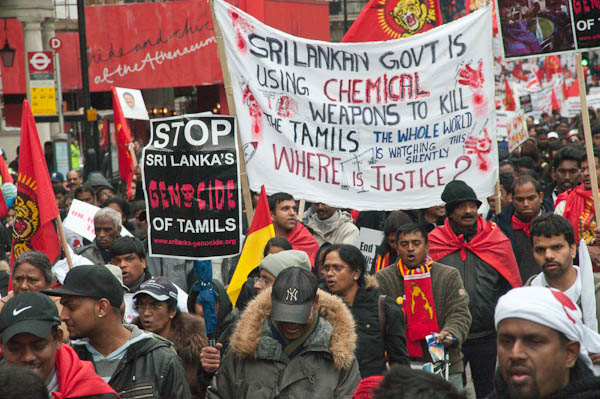
When even the police give an estimate of numbers as 100,000 you can be sure it is a very big march, and as the crowds were generally pretty solidly packed there seems little reason to question the independent estimates of around 150-200,000 people.
The vast majority of them were Tamils, with probably only a few hundred white faces. There didn’t seem to be a great deal of media interest, and I saw no photographers from major newspapers or news agencies and no cameras from major UK TV stations. It was such a large event that I could have missed them, but usually at the start of marches there is a crowd of media in front, while on Saturday there was just me, three other photographers, none of whom get regular work for the mass media and a Tamil with a video camera.
However it was reported by some, including the BBC where three very short paragraphs and an indifferent photo accompany a longer piece on the two Tamil hunger strikers in Parliament Square.
It was quite a contrast with the Bethnal Green march on the death of Ian Tomlinson earlier in the day, a small event where there were almost as many media as marchers, with all the major agencies, papers, channels and most of the freelances I know putting in an appearance.
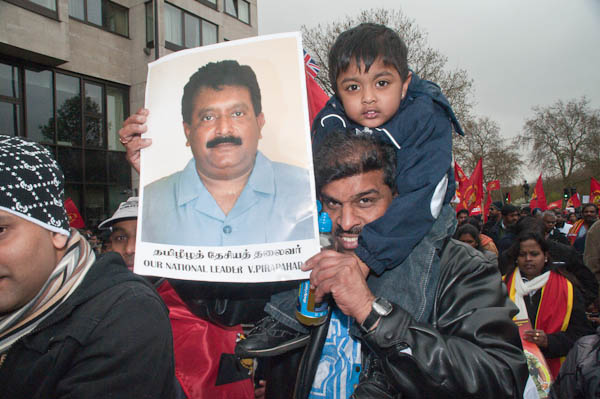
Photo of Velupillai Pirapaharan, founder and leader of the LTTE
The Tamil march was also very much a family event – at one time I found myself facing a row of around 20 push chairs, and they were many children carrying placards and being carried on shoulders, as well as crowds of young people and students, and adults of all ages, including some who looked old enough to be my mother or father.
They were united in their opposition to the killing of Tamils in Sri Lanka, but also the vast majority of those marching in some way expressed their support for the LTTE, the Liberation Tigers of Tamil Eelam. A few carried actual tigers, fortunately only large toys, but many wore the colours or carried flags or portraits of the founder and leader of the Tamil Tigers, Velupillai Pirapaharan (sometimes spelt spelt Prabhakaran.)
In the UK, the LTTE has been a proscribed organisation under the Terrorism Act 2000 since 2000. This makes it a terrorist offence for a person to support the group or wear clothing which arouses the “reasonable suspicion that he is a member or supporter of a proscribed organisation.” Police sensibly made no attempt to arrest all 200,000 marchers on Saturday despite their clear breach of the Act.
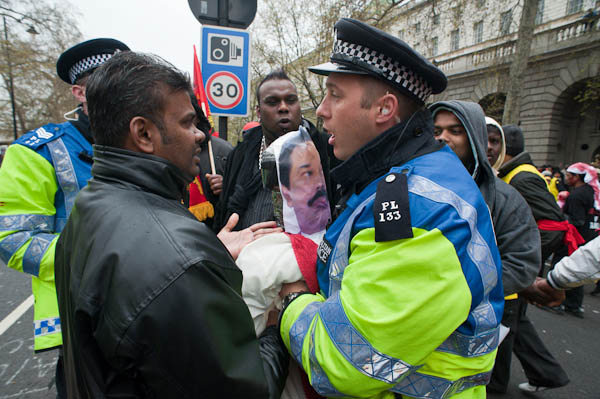
Police object to a dummy with the President’s face
Although enthusiastic, the Tamils had no intention of causing serious trouble in London and only three arrests were reported. I saw only one small incident, where police prevented marchers from carrying a dummy with a photograph which of Sri Lanka’s President Mahinda Rajapaksa as its face. Once this photograph was removed they allowed them to continue.
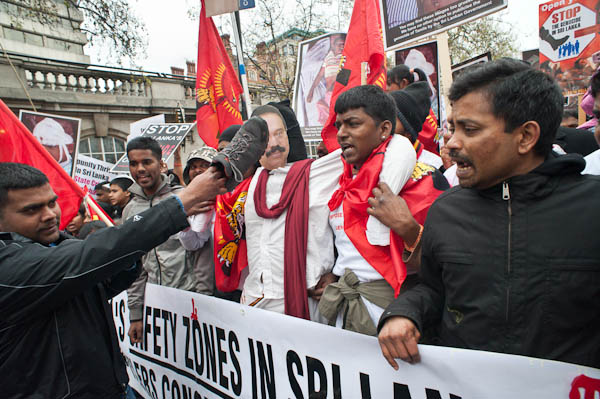
But her’s another getting shoe’d
Britain has a long history of lack of care for the Tamils in Sri Lanka, going back to colonial days. When we gave Ceylon independence in 1948 we neglected to take any precautions to safeguard their interests. Within a very short time many had been disenfranchised and deported as “Indian Origin” Tamils, whose ancestors had been brought to the country by the British in the middle of the previous century. Since then there has been a continued programme of repression, religious discrimination and marginalisation of Tamils, with Sri Lanka being established as a Buddhist republic in 1972. The LTTE was founded in 1976, and for some years until 2006 large parts of the Tamil areas of the country came under their civil administration.
At least a part of the LTTE success for many years came from the extreme and desperate measures that they have used, including assassinations and suicide bombings. Both sides in the conflict have committed numerous atrocities against civilians. Various international attempts to broker peace over the years came to an end in 2006, since when the Sri Lankan army has been engaged in a full-scale assault on the Tamil areas and the LTTE seem now very close to final defeat as an organised military force, although they are expected to re-emerge as a guerilla group.
At the moment the Sri Lankan government’s policy appears to be aimed at the complete annihilation of the LTTE and much of the Tamil population. Others are being resettled in transit camps and then ‘welfare villages’ which may seem rather more like prison camps than normal life. At the moment it seems unlikely that there will be any effective intervention by outside powers to prevent the genocide of the Sri Lankan Tamils; David Miliband did phone to ask the Sri Lankan government not to return to a full-out assault following their two-day cease-fire,but his plea seems unlikely to be taken seriously. The situation is desperate and although marches like this should call attention to it, the mass media hardly seem to find it newsworthy. We appear to be approaching a truly scandalous climax to years largely of scandalous indifference.
It takes only a few seconds to send an e-mail letter to the UN High Commissioner for Human Rights about the Tamil crisis and there is also a petition form which can be downloaded on the Tamil Writers Guild, for filling in and faxing to your MP or Gordon Brown.
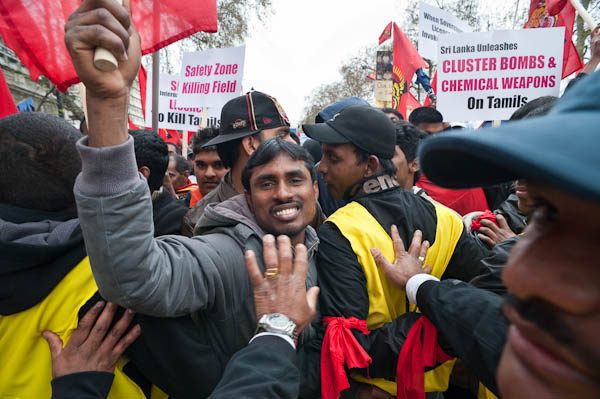
Though you do mention the Tamil Tiger atrocities, your report seems sensationalist and one-sided. The killing is nasty, but to call it genocide just serves to overuse the word and bolsters the current trend of so many to over emote in an unhelpful way. There is no evidence of Sinhalese genocide, and no reputable source is using the word as far as I know. Anyway, it seems pretty clear that the Tigers are holding the civilian population captive, in order to make it more difficult for the government to finish them off, and are using their captives, particularly the boys, to reinforce their fortifications and fight for them under duress if they can make them – even the UN observers seem to be saying this.
If anyone has been responsible for butchering Tamil civilians over the past ten years, it’s the Tigers – thats why they have sunk to such a low level of support from their own community in Sri Lanka – and that’s why they have been losing ground. I’ve spoken to many Sri Lankan Tamils, and all of them expressed hatred and fear of the Tigers. It is only the exiled Tamil community, immune to their abuses and able to fall back on a sort of knee jerk racist nationalism that still supports them. The exiles perhaps have memories of more than ten years ago when the Tigers were more representative.
I feel sorry for the Tamils, they have, no doubt been unfairly treated, but is the government just supposed to let the Tigers hack off 50% of the land (the Tiger claimed Elam) on demand? They make up only 15% of the population, but that never stopped the Tigers making their unrealistic and unachievable claims. It is the Tigers that have caused more problems for the Tamils than any Sinhalese government.
The government now has the last of these ruthless, butchering terrorists cornered – the only sensible thing is to keep up the momentum and wipe them out as an organised military force, only then can any sensible negotiations for Tamil rights take place. It’s up to the Tigers to release their captives in order to avoid a senseless bloodbath. For the government to back off now under all the disingenuous hand-wringing international pressure would simply let the Tigers survive to regroup and continue with their atrocities.
Remember, the Tamils have a homeland, their ancient, historic Hindu one in Tamil Nadu, in India. The Sinhalese only have Sri Lanka, their ancient Buddhist home. There are already a billion Hindus in India, are they to push those who wish to preserve their Buddhist cultural heritage off the continent altogether?
This isn’t the BBC. But I do believe in looking objectively at the evidence, and in virtually all the historical conflicts I’m aware of there have been overwhelming reasons to support one side rather than the other – to be against Franco, against Hitler, against the US in Vietnam, against Britain and France at Suez, against the Israelis in Gaza… And of course against the government in Sri Lanka. So yes, I’m happy in that sense to be one-sided, although I claim not to be blindly so.
I doubt if you have read all the pieces I’ve written here and elsewhere on Sri Lanka and its history. It is crystal clear that the Tamils have been extremely badly treated over the years. You seem to be unaware that part of the island was historically a Tamil kingdom – certainly since the third century BC and probably considerably earlier – and that the island was only united under British rule. Tamils belong there just as much as the Sinhalese.
The British granted independence with a constitution that allowed the majority to engage in a systematic campaign over the years against the Tamils. Many were deported, including some families that had been on the island for three or more generations, laws marginalised the Tamil language and people, anti-Tamil riots and massacres were encouraged and much more. It has been a long-term and systematic campaign against a people on the grounds of race with the aim of getting rid of them.
And of course as you admit I’m aware of the atrocities carried out by the Tamil Tigers – as well as their successes in running a civil economy when they were able to do so. They have also contributed to the breaking down of caste barriers and liberating women.
The situation in Sri Lanka would be much better and much more clearly understood around the world if there was a free press – but as we know, Tamil journalists have been murdered and the international press largely banned. Aid organisations and the UN continually complain about the lack of access they have been allowed. If the government had allowed the development of moderate organisations that furthered the aspirations of the Tamil people they would be in a very different situation now.
I think virtually the whole world is now behind the demonstrators in calling for an immediate ceasefire. Frankly I don’t think going on with the killing – which will result in many civilian deaths whether or not the LTTE are holding some people in the area – and the placing of the others into ‘holding camps’ presents any future for the Tamils of Sri Lanka.
I did not disagree that the Tamil’s have been badly treated, and no doubt this merited resistance. My point was that this treatment has been nothing like genocide, and to use it in this context seems sensationalist and rather foolish.
The point of this war is to wipe out a particularly brutal and politically unrealistic group, the Tigers which has militarised so many of the community to an almost psychopathic degree, and stops at nothing to kill and maim. All this has led to is a continuously rising death toll, execution of any alternative politicians with a different approach to the Tamil problem, the stiffling of any realistic political process and a great deal of suffering for ordinary Tamils.
To let them go at this point, which is what a ceasefire will amount to is simply to continue to allow the same old brutal attrition, unachievable aims, and the repression of an alternative voice of dissent that might actually get somewhere.
As to the history of Sri Lanka, yes, Tamils have been a continuous presence in the north of the island for many centuries, and every now and then, through invasion and the rise of empires, from the Chola period on, they have ruled large sections of the island. That still does not address the real concerns of the majority of Sri Lanka’s population, the Buddhist Sinhalese, who want to maintain a certain level of cultural integrity, faced with a sea of far more powerful Hindus to the north. Obviously there has to be some sort of compromise – Tamil rights and the easing of Sinhalese concerns – This will never be achieved by brutal and unrealistic terrorism.
As to the notion that the Tigers have eased caste discrimination and helped in the liberation of women, well, that was necessary for effective military cohesion, and the price for that was ruthless military hierarchies using child soldiers and suicide bombers. Ironically it is, anyway, only really a problem among the Tamil Hindus and not among the Buddhist Sinhalese, who are far less affected by caste or the oppression of women.
Much of contemporary journalism seems to me to be reactive and very much directed by what is easy to report on and what appeals to a very sentimental form of a sense of justice. So the plight of thousands of Tamil civilians, being shelled while trapped in a small beachhead, or Gazans being shelled by Israelis, especially when supported by pictures is far more newsworthy, causes far more angst, hand-wringing, and shuttle diplomacy, especially if there is a highly charged and demonstrative diaspora who can agitate for them, than the genuine genocides of places like Darfur.
It also helps journalists if there is a bogeyman to vent bile on, of course much more to do with the psychology of sections of the general public than the objects of hatred themselves. In this respect Israel, or the US, or any ‘strong’ government have always served for the liberal left.
In places like Darfur, however, the Arab Muslims are the bogeymen, and this is a difficult and problematic area for most liberals, so, even though 300,000 people have been killed, almost 2 million made homeless, there is systematic and brutal rape, and there is a great deal of evidence that the Arabs want to wipe out the Blacks there, it is, relatively, ignored.
I don’t want to get into measuring atrocities – they are all bad and should all be sensibly alleviated if they can be, if it is also for the long term good. However, they are all also much more complex than you seem to want to allow.
It is also interesting to note the almost complete lack of journalists getting involved in reporting from Darfur, a conflict and massacre on a far greater scale at a much higher level of brutality and fatality.
Try getting the BBC to talk about the Muslim massacres there, they wont. They will also not publish letters that have genocide and Muslim in the same paragraph – I’ve systematically tried it – so that’s one explanation for the relative lack of reporting there – offending Muslim sensibilities.
Another is that journalists are too afraid to go there and report – understandably – the Sudanese government is repressive and ruthless.
The third, is that there is no Darfurian diaspora to agitate in western capitals – and this is what I mean by journalism being opportunist and reactive.
Journalists react to the Palestinians, they react to the Tamils, they react to their own personal bogeymen, they fear stirring up ‘Muslim sensibilities’ and they fear certain places, both for their safety and also for their discomfort. All pretty pathetic really, no real basis for integrity, and certainly no basis for assessing the relative merits of the various sides.
“The genocide in Darfur has being going on for so long that it seldom makes the news, which is perhaps why none of the newspapers could be bothered to send anyone to cover the demonstration in London calling for Justice for Darfur and for those accused of war crimes there to be sent for trial at the International Criminal Court.”
This was the start of one of a number of pieces I’ve written about Darfur over the years, here and elsewhere. But that doesn’t make what has happened over the last 51 years or so in Sri Lanka any more palatable.
Of course everything is more complex than any particular article by anyone suggests; really that is just a truism which there seems little point in stating.
There are particular reasons for me to write about the Tamils, not least because it is a situation where the current UK government could apply a great deal more pressure than it is currently doing, and also one for which part of the blame lies with previous UK governments over many years.
The presence of such a large Tamil diaspora is of course in part a result of the systematic efforts of the Sri Lankan government over the years to reduce the Tamil population of the island. It is this same government that has essentially refused over the years to entertain any settlement that would have guaranteed both Tamil and Sinhalese rights. Unfortunately I don’t think there ever was any other possibility for the Sri Lankan Tamils that would have been more successful, nor do I think the future has anything to offer them.
I don’t think the situation on reporting differs greatly between the two situations. Access isn’t really possible in either case. I don’t think that journalists in general deserve the kind of comments you make – many, particularly photographers, put themselves at considerable risk in various conflicts around the world, and often do so with little or no financial support and it isn’t unusual for them to end up out of pocket – just look at what fills newspapers and magazines these days and it is clear why.
I seldom see evidence of lack of integrity among my fellow journalists and photojournalists in the NUJ. Even at the BBC you are generally wrong in blaming journalists – it is seldom them who make the decisions about what is or isn’t news or what the BBC policy is.